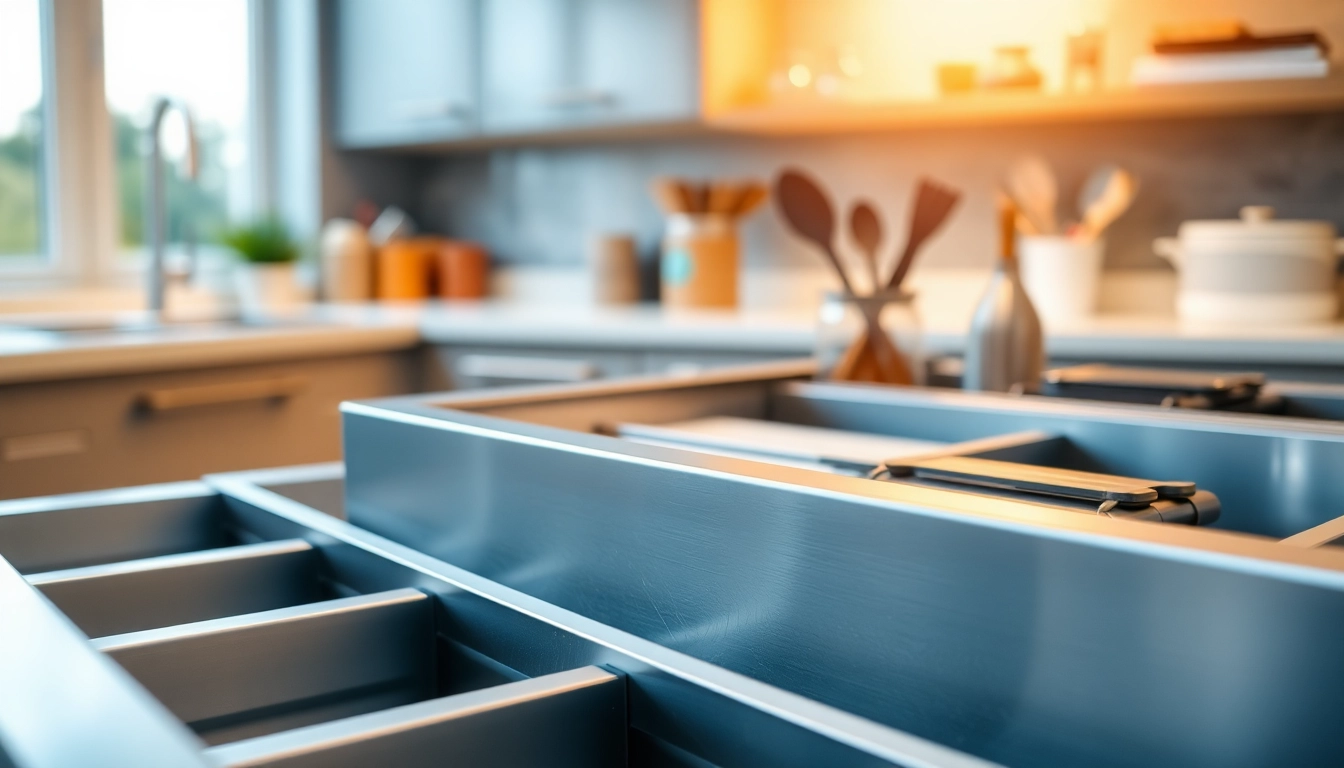Understanding Metal Drawer Systems
In today’s world of efficient organization and modern design, a quality Metal Drawer System plays a crucial role in homes and workplaces alike. These systems are designed to enhance functionality, durability, and aesthetics, making them a preferred choice for both commercial and residential applications.
What is a Metal Drawer System?
A metal drawer system is a hardware configuration that facilitates the smooth sliding of drawers in cabinetry, workspaces, and mobile storage units. It typically consists of metal drawer boxes, slides, and various connectors that work together to provide a sturdy and reliable solution for storing items. The key advantage of metal over other materials, like wood or plastic, is its strength and durability. Metal drawer systems can handle heavier loads and are less prone to warping over time, making them ideal for various applications ranging from kitchen cabinets to industrial workstations.
Key Components of Metal Drawer Systems
Metal drawer systems are comprised of several essential components:
- Drawer Box: Often constructed from high-grade metal, the drawer box is the core component that holds items. The box’s design can vary, including options like single-wall or double-wall construction for increased capacity and stability.
- Drawer Slides: These are the mechanisms that allow the drawer to open and close smoothly. Common types include side-mount, undermount, and center-mount slides, each offering unique benefits in terms of space-saving and ease of use.
- Front and Rear Brackets: These components attach the drawer to the slides and keep it aligned and secure during movement.
- Rail System: This includes the tracks along which the drawer slides, crucial for ensuring smooth action and stability.
Benefits of Using Metal Drawer Systems
Opting for metal drawer systems comes with numerous benefits:
- Durability: Metal is resistant to wear, punctures, and shocks, making it a long-lasting solution.
- Heavy Load Capacity: Metal drawer systems can typically support heavier loads compared to their wooden counterparts, which is paramount in both residential and commercial settings.
- Design Versatility: They can come in various finishes and styles, allowing for seamless integration into any design scheme.
- Ease of Maintenance: Metal surfaces are easier to clean and resist staining better than wood, enhancing hygiene in areas like kitchens.
- Increased Efficiency: With features like soft-close and full-extension slides, users can access all items within the drawer easily, improving overall efficiency.
Types of Metal Drawer Systems Available
Standard vs. Heavy-Duty Metal Drawer Systems
Metal drawer systems come in various grades to meet differing use cases:
Standard Metal Drawer Systems are designed for everyday use in home and office settings. They usually support moderate loads — ideal for tool drawers, kitchen cabinets, or office supplies. Commonly, these systems utilize lighter gauge metals for cost-effectiveness without sacrificing quality.
Heavy-Duty Metal Drawer Systems, on the other hand, are built to withstand significantly higher loads, often used in workshop environments or industrial applications. Materials used are typically thicker, ensuring enhanced strength and stability. These systems are vital for high-traffic areas where durability is paramount, such as tool storage or production facilities.
Comparing Undermount and Side-Mount Drawer Slides
Drawer slides are crucial in any metal drawer system, and choosing the right type is essential for functionality and design:
- Undermount Slides: These slides are hidden beneath the drawer, providing a clean and finished look. They also allow for full access to the drawer’s contents. Additionally, undermount slides are often soft-close, preventing slamming and enhancing user experience.
- Side-Mount Slides: Mounted on the sides of the drawer, these slides are easy to install and adjust. They offer robust support for heavier loads, making them suitable for tools and equipment. However, they may be more visible and may not offer the same smooth close as undermount systems.
Customizable Options in Metal Drawer Systems
Customization is where metal drawer systems can truly shine. Many manufacturers offer tailored options including:
- Custom Sizes: Depending on the space available, it’s possible to order drawers in various sizes, depths, and widths.
- Finish Choices: Metal surface finishes can include powder coating, chrome plating, or brushed steel, each providing different aesthetic and practical benefits.
- Special Features: Innovative extras such as integrated dividers, built-in locks, or eco-friendly materials are becoming increasingly popular as industries respond to consumer demand for personalization and sustainability.
Choosing the Right Metal Drawer System for Your Project
Assessing Your Storage Needs
Before selecting a metal drawer system, it’s crucial to evaluate what you need it for:
Think about the items you’ll store. Are they heavy tools, kitchen utensils, or files? Assessing the weight, size, and frequency of use of these items can guide you towards the most appropriate type of metal drawer system.
Factors to Consider When Selecting a Metal Drawer System
When considering which system suits your needs best, take these factors into account:
- Load Capacity: Ensure that the system can handle the weight of the contents, factoring in both daily loads and potential overloads during use.
- Durability Requirements: Consider the environmental conditions where the system will be used — is it a moist environment, or will it experience frequent temperature changes? This can influence material choice.
- Aesthetic Preferences: Ensure that the design and finish align with the overall decor of your space.
- Ease of Installation: Some systems are easier to install than others. Evaluate your DIY capabilities or the availability of professional installation services.
Installation Tips for Metal Drawer Systems
To ensure a successful installation of your metal drawer system, follow these insightful tips:
- Read the Instructions: Always start by reviewing the manufacturer’s installation guide for specific instructions tailored to your model.
- Gather the Right Tools: Having the appropriate tools, such as screwdrivers, measuring tape, and a level, will make your installation smoother and quicker.
- Measure Twice, Cut Once: Precision is endorsed during the measurement to avoid any misalignment. Confirm the dimensions of both the cabinet space and the drawer unit before drilling any holes.
- Leveling is Key: Ensure that the drawer slides are level during installation to facilitate smooth opening and closing operations.
- Safety First: Use safety gear when handling metal components to avoid cuts and injury.
Common Issues with Metal Drawer Systems
Identifying and Resolving Drawer Slide Problems
Even high-quality metal drawer systems can experience issues over time, and it’s essential to identify and solve them promptly:
- Misalignment: If drawers are not sliding smoothly, check if they are properly aligned. Adjust the mounting hardware as necessary.
- Obstructions: Items stuck between the drawer and slides may hinder movement. Regularly check for obstructions and clean the slides if dust accumulates.
- Worn Components: Slides may wear out over time. Inspect for signs of damage and replace components if necessary.
Maintenance Best Practices for Longevity
Maintaining your metal drawer system extends its lifespan. Here are some strategies to keep it in optimal condition:
- Regular Cleaning: Periodically clean drawer interiors and the slides to prevent dust and debris buildup.
- Lubrication: Apply a silicone-based lubricant to the slides to ensure smooth action.
- Check for Wear: Regularly inspect components for signs of wear and replace them if necessary.
When to Replace Your Metal Drawer System
Even the best systems will need replacement eventually. Here are signs that it may be time for a new metal drawer system:
- Structural Damage: Significant dents or cracks can compromise the integrity of the drawer and must be addressed immediately.
- Frequent Malfunctions: If you are regularly fixing slides or other components, consider replacing the entire system.
- Decreased Load Capacity: If the drawer cannot hold standard weights anymore, it might be time for an upgrade.
Innovations in Metal Drawer System Design
Trends in Metal Drawer Systems for Modern Homes
As design trends evolve, so do metal drawer systems. Current trends focus on:
- Minimalist Design: Sleeker lines and more understated designs are becoming prevalent, contributing to a clean aesthetic.
- Integrated Technology: More systems are integrating technology features such as built-in lighting or wireless charging capabilities.
- Customized Solutions: Highly specialized systems that cater to unique organizational needs are increasingly in demand.
Smart Features in Contemporary Metal Drawer Systems
Modern metal drawer systems are also incorporating smart features to enhance usability:
- Self-Closing Mechanisms: Many systems now come with soft-close features that prevent slamming and reduce noise.
- Built-in Safety Locks: For home offices or spaces with valuables, safety locks can deter unauthorized access.
- Enhanced Glide Systems: Advanced ball-bearing designs provide quieter and smoother operation, improving user experience.
Sustainability and Material Choices in Metal Drawer Systems
As consumers become more environmentally conscious, the demand for sustainable materials is on the rise:
Metal drawer systems can now be made from recycled materials or sustainable practices, helping to minimize environmental impact. Additionally, manufacturers are exploring eco-friendly finishes that do not compromise aesthetic appeal or durability.



